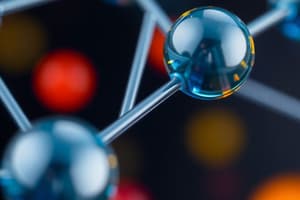Podcast
Questions and Answers
Which four elements make up 96% of living matter?
Which four elements make up 96% of living matter?
- Phosphorus, Calcium, Sulfur, Potassium
- Carbon, Hydrogen, Oxygen, Nitrogen (correct)
- Iron, Copper, Zinc, Manganese
- Sodium, Chlorine, Magnesium, Iodine
What determines the chemical behavior of atoms?
What determines the chemical behavior of atoms?
Electrons
Atoms tend to complete a partially filled ______ shell.
Atoms tend to complete a partially filled ______ shell.
valence
Water is a polar molecule.
Water is a polar molecule.
What is the pH of a neutral solution?
What is the pH of a neutral solution?
Which processes do buffers perform?
Which processes do buffers perform?
What are the four main types of biological molecules?
What are the four main types of biological molecules?
Match the following biological molecules with their functions:
Match the following biological molecules with their functions:
Hydrophobic substances have an attraction to water.
Hydrophobic substances have an attraction to water.
The pH scale measures how ______ or basic a solution is.
The pH scale measures how ______ or basic a solution is.
What is the effect of pH on cellular function?
What is the effect of pH on cellular function?
Flashcards are hidden until you start studying
Study Notes
Chemical Elements in Life
- 25 elements are essential for life
- Four elements make up 96% of living matter: Carbon (C), Hydrogen (H), Oxygen (O), and Nitrogen (N)
- Four elements make up most of the remaining 4%: Phosphorus (P), Calcium (Ca), Sulfur (S), and Potassium (K)
Atomic Structure and Bonding
- Atoms are the basic building blocks of matter
- The outermost shell of an atom, the valence shell, determines its chemical behavior
- Electrons fill shells from the inside out: 1st shell holds 2 electrons, 2nd shell holds 8, and 3rd shell holds 8
- Elements in the same row of the periodic table have the same number of shells
- Elements in the same column have the same number of valence electrons and similar chemical properties
Chemical Bonds
- Covalent bonds: Two atoms share a pair of electrons, forming molecules
- Hydrogen bonds: Weak attractions between polar molecules, like water molecules, due to the attraction of a positive hydrogen atom to a negative oxygen atom
- Ionic bonds: Transfer of electrons from one atom to another, creating ions
Importance of Water in Biology
- Water is essential for all life, existing both inside and outside cells
- Cohesion: Water molecules are attracted to each other due to hydrogen bonding, leading to surface tension and capillary action
- Adhesion: Water molecules are attracted to other substances, also due to hydrogen bonding.
- Solvent: Water is a good solvent for many molecules, due to its polarity.
- Lower density as a solid: Ice floats because it's less dense than liquid water
- High specific heat: Water can absorb a lot of heat before its temperature changes significantly
- High heat of vaporization: Water requires a lot of energy to evaporate
Hydrophilic and Hydrophobic Interactions
- Hydrophilic: Substances that are attracted to water, often polar molecules
- Hydrophobic: Substances that are not attracted to water, often non-polar molecules
pH and Buffers
- pH scale: Measures the acidity or alkalinity of a solution, ranging from 0 to 14
- Acid: A substance that releases hydrogen ions (H+)
- Base: A substance that accepts hydrogen ions
- Buffer: A solution that resists changes in pH
Functional Groups
- Hydrocarbons: Mostly carbon and hydrogen, relatively unreactive but become more active when functional groups are added
Carbohydrates
- Provide energy and structural support
Proteins
- Perform various functions like enzyme activity, structure, and immune responses
Lipids
- Store energy, form cell membranes, and act as signaling molecules
Nucleic Acids
- Store and transmit genetic information (DNA and RNA)
Studying That Suits You
Use AI to generate personalized quizzes and flashcards to suit your learning preferences.




